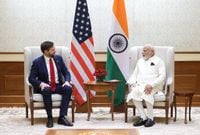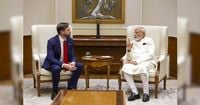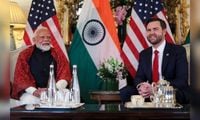India and the United States have made significant strides in their ongoing trade discussions, as both nations have finalized the terms of reference for a proposed Bilateral Trade Agreement (BTA). This announcement came after a pivotal meeting between Indian Prime Minister Narendra Modi and U.S. Vice President JD Vance in New Delhi on April 21, 2025.
The U.S. Trade Representative (USTR), Jamieson Greer, emphasized that these negotiations aim to establish balance and reciprocity in trade relations, thereby opening new markets for American goods while addressing practices that disadvantage U.S. workers. "India's constructive engagement so far has been welcomed, and I look forward to creating new opportunities for workers, farmers, and entrepreneurs in both countries," Greer stated.
This latest development builds on a series of discussions initiated on February 13, 2025, when Modi visited President Donald Trump and both leaders agreed to pursue a BTA. The first phase of negotiations is expected to be completed by September or October of this year, marking a crucial timeline for both countries.
During the talks, the USTR noted a "serious lack of reciprocity" in the trade relationship between the two nations. The U.S. has been vocal about its concerns regarding the trade barriers that have historically limited American exports to India. In 2024, the U.S. recorded a substantial goods trade deficit of $45.7 billion with India, reflecting a 5.1 percent increase from the previous year.
According to USTR reports, total goods trade between the two countries was estimated at $129.2 billion in 2024. The average applied tariff in India stands at 17 percent, significantly higher than the U.S. average of 3.3 percent. Particularly in the agricultural sector, India's average tariff rate is 39 percent, while the U.S. charges only 5 percent.
Greer highlighted that in addition to tariffs, several other barriers hinder U.S. exports to India, including technical barriers to trade, regulatory restrictions, and limited access to markets across various sectors such as services, industry, and agriculture.
In a bid to foster a more favorable trading environment, the U.S. welcomed India's recent tariff reductions, which were discussed during Modi's meeting with Trump in February. As part of the BTA negotiations, India has expressed a willingness to further lower tariffs on U.S. products.
On April 2, 2025, President Trump imposed a baseline tariff of 10 percent on all countries and set higher tariffs for those with which the U.S. has significant trade deficits. This move was described as an effort to "level the playing field" for American businesses.
The finalized terms of reference will address critical issues such as tariffs, non-tariff barriers, rules of origin, and customs facilitation. Greer stated that achieving reciprocal trade with India is essential for delivering results that benefit the American people.
In another significant development, the U.S. and Indian governments are working towards an interim trade deal that could be announced even before the final BTA is signed later this year. Special Secretary Rajesh Agrawal, one of India's top trade negotiators, is scheduled to travel to the U.S. this week for in-person discussions with American officials.
Vice President Vance's visit marks the first U.S. vice presidential trip to India in 12 years, highlighting the importance of the bilateral relationship. The U.S. and India have maintained a strategic partnership, with both nations keen to enhance economic ties.
As the negotiations progress, both sides are optimistic about the potential for a mutually beneficial agreement. Finance Minister Nirmala Sitharaman, who is currently in the U.S., reiterated the commitment from both countries to finalize the first phase of the trade deal by the fall.
The ongoing trade discussions come at a critical time as both countries seek to strengthen their economic ties amidst global trade challenges. As the world navigates through uncertainties, the India-U.S. trade relationship is poised to play a significant role in shaping economic policies and trade dynamics.
In conclusion, the finalized terms of reference for the Bilateral Trade Agreement represent a crucial step forward in the India-U.S. trade relationship. With both nations committed to addressing trade barriers and enhancing market access, the potential for a successful agreement appears promising.







